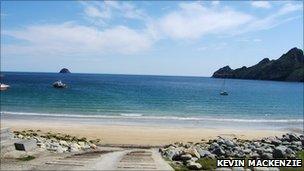The new residents of St Kilda archipelago
- Published
Generations of islanders survived on a diet mainly made up of seabirds and local produce.
Eighty years after it was evacuated, St Kilda is a temporary home to as many people as there were on the islands at the time they were abandoned.
The last 36 St Kildans left on 29 August 1930 because life had become too difficult on the remote archipelago.
But summer can see as many as 35 people living on the main island of Hirta.
They are a mix of staff from owners National Trust for Scotland (NTS), Ministry of Defence workers, volunteers and scientists.
Their occupations would have been alien to the weavers and crofters who once lived in one of the remotest corners of the British isles.
St Kilda is managed by NTS, but defence staff and employees from defence contractor QinetiQ also work at the test rocket tracking station.
Over the winter, the military station has about 10 staff, each living on the islands for a month at a time. Trust employees leave the islands for the winter.
With its sheer cliffs and monster tooth-like sea stacs, the group of islands have been described as a "lost world" and could easily have made a fitting backdrop to Steven Spielberg's film Jurassic Park.
Loom spinners
But for short periods of time it is called home by its new residents.
A spokeswoman for NTS said: "The numbers of people staying on St Kilda can change from day to day.
"Over the summer it can go up to 30 to 35 people and they are made up of National Trust for Scotland staff, contractors, researchers and volunteers in trust work parties."
Last Thursday, there were 22 people on St Kilda but two were due to leave by the end of Friday.
Recent census have recorded people on the archipelago.

The main island of Hirta was evacuated on 29 August 1930
Nine were recorded in 1981, but none in 1991 or 2001, highlighting the temporary nature of its population today.
Papers from the 1901 records lists dozens of people, families with members aged from seven to 76 and occupations such as hand loom spinners of wool and grounds officer and crofter.
People had lived on St Kilda, the westernmost islands of the Outer Hebrides, since prehistoric times.
But life there was constantly challenged by the weather, disease and later a growing dependency on links with mainland Britain.
Smallpox ravaged Hirta in the 1720s and killed almost 200 St Kildans.
One adult and 18 children survived along with three men and eight boys who had been stranded on a sea stac for nine months after a boat failed to collect them following a seabird, or guga, hunt.
Landlord MacLeod of Dunvegan moved tenants from Skye and Harris to the archipelago in an effort to repopulate it.
Survivors quarantined
However, descendants of these new St Kildans were on the move themselves.
In the 1850s, 42 of the islanders emigrated to Australia, half of them dying on the way.
Eric Richards, professor of history at Flinders University in Adelaide, believes the deaths and the survivors' first experiences of Australia deterred potential emigrants.
The survivors were quarantined on arrival in Port Phillip and were also treated less well because they spoke Gaelic and not English.
Prof Richards said the tales of woe was a factor in ending large-scale emigration from the Highlands.
The 19th Century also saw tourists visiting the islands and an effort to improve life for the islanders.
One of the so-called improvements was 16 new houses that were built in the village in 1860.
These new houses were cold and it was necessary to import coal from the mainland, the supplies of peat not being enough to heat them.
Neither could they be repaired with local materials.
During World War I a Royal Navy detachment to Hirta meant regular deliveries of mail and food for sailors and the islands' residents.
However, the end of the war and withdrawal of the unit reinforced a feeling of isolation among the community.
The winter of 1929 was so hard some inhabitants died.
The remaining 36 islanders wrote to the government asking to be taken off and start a new life on the mainland. Hirta was abandoned the following year.
But today, St Kilda is far from being deserted islands.
- Published13 August 2010
- Published3 August 2010
- Published12 July 2010